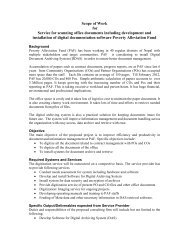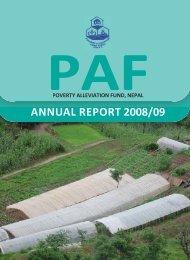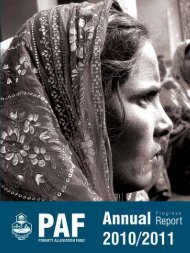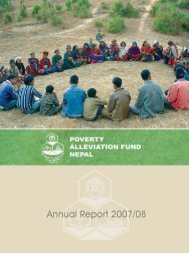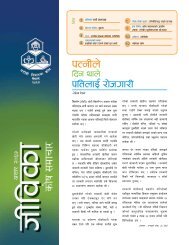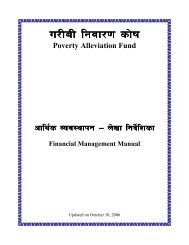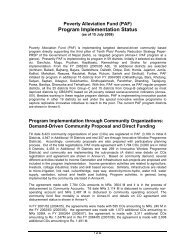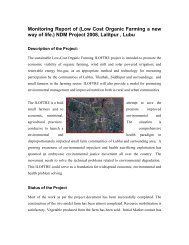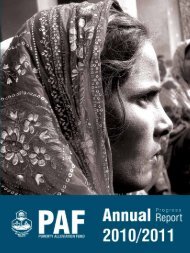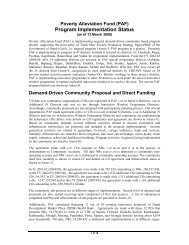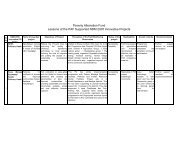Jeevika - VOL 1, NUMBER 2, MARCH 2007 - Poverty Alleviation ...
Jeevika - VOL 1, NUMBER 2, MARCH 2007 - Poverty Alleviation ...
Jeevika - VOL 1, NUMBER 2, MARCH 2007 - Poverty Alleviation ...
You also want an ePaper? Increase the reach of your titles
YUMPU automatically turns print PDFs into web optimized ePapers that Google loves.
INSIDE3456 Snippets8PAF Gets New VCDistrict Focus: MuguSuccess StoriesFocus Area:Income Generation andMicro-Enterpris PromotionM A R C H 2 0 0 7Empoweringthe disempoweredManoj Harijan, a Dalit from Dhankauli-5, Kapilvastu, who couldhardly earn Rs 24 a day previously, now earns Rs 150 a day.He is no longer a Haliya (bonded labour). He says he is nowfree from the torture he used to get from the local landlords.He is mulling to buy another Rickshaw to raise his families."Life has a different meaning for me now", says elated Harijan.Gopal Bahadur Magar, a member ofethnic Magar Community, RampurVDC, Ramechhap earns a decent livingfrom his Nursery. He received trainingson nursery management and he now runsa nursery in his village, providingseedlings of different fodders and fruits.Malati Lama, a woman in her fifties,Lalpur-6, Siraha runs a retail business. Aformer wage labourer- Lama wishes toexpand business. “If poor gets a little bitof support, they will definitely improvetheir living conditions,” Says Lama.Harijan, Magar, and Lama are mere threeof thousands of dalits, ethnic groupsand women who have benefited fromthe PAF’s initiatives aimed at addressingexclusion.PAF, established for the purpose ofpoverty alleviation under the WorldBank’s support, has recognized thatexclusion is one of the underpinningfactors of poverty in Nepal. Hence,inclusion of community excluded by thevirtue of gender, caste and ethnic originis one of its major goals. It has adopteda modality to address the issue throughthe implementation of targetedprogramme.Under the programme operationmodality, PAF has made sure that theCommunity Organizations thatimplement PAF programme havesufficient participation of excludedgroups.PAF has channelled its programmes inpoor households, like that of Harijan,Magar and Lama, who are defined as thehouseholds whose food grainproduction from self-operated land andwage earnings are sufficient to meet thefood requirement of the family for lessthan a year......cont. on page 7
2A TRIMESTER NEWSLETTER OF PAF<strong>VOL</strong> 1, <strong>NUMBER</strong> 2, <strong>MARCH</strong> <strong>2007</strong>Editorial AdvisorRaj Babu ShresthaEditorShree Ram Subedi<strong>Jeevika</strong> is published on trimester basisby the <strong>Poverty</strong> <strong>Alleviation</strong> Fund.Readers are welcome to distribute andreproduce the contents of the Newsletterwith the appropriatecredits to <strong>Poverty</strong> <strong>Alleviation</strong> Fund<strong>Poverty</strong> <strong>Alleviation</strong> Fund (PAF)Chakupat, LalitpurP.O. Box 9985, Kathmandu, NepalTel: +977-1-5553671/5553672/5553673Fax: +977-1-5553674E-mail: pafnepal@info.com.npFor a broader range ofresources and informationabout <strong>Poverty</strong> <strong>Alleviation</strong> Fund (PAF),please visit our website: www.pafnepal.org.npJOHN W. MELLOR*PRESIDENTJOHN MELLOR ASSOCIATES, INC.Complementaritiesbetween PAF and APPEstablishing complementaritiesbetween programmes designed toreduce poverty and programmes toaccelerate agricultural growth rate arecomplex, but important. This write-updivulges into the key aspects of thisrelationship.Growth is Essentialto Break the Back of <strong>Poverty</strong>Cross-country and cross-state studies ofRavallion and his colleagues at the WorldBank, Timmer and his colleagues atHarvard University and Thirtle at DFIDhave shown that rural and agriculturalgrowth contributes more to reduce povertythan urban or industrial growth. Mellor andhis colleagues have provided insight of thisrelationship and have emphasized onsupport to the rural non-farm sector forgrowing farm incomes. The Indian dataalso shows that direct action programmeshave little aggregate effect on povertyreduction due mainly to populationgrowth, as it expands the number of poorfaster than what the poverty programmescan lift out of poverty. Hence, the growthprogrammes, which utilize publicexpenditure to empower private resources,particularly land and labour of farmers,break the back of poverty.Shortcomings to GrowthHowever, there are severe shortcomings ofgrowth in poverty reduction. Specializedpoverty alleviation programmes can counterthose by dealing with following gaps.Firstly, there are substantial lags fromAgricultural Perspective Plan (APP) typeinvestment in the growth of farmproduction and income generation. Lagsexist because public spending takes fewyears before actually triggering the growthof farm income. Statistical analyses haveshown that such time lag could rangefrom 3 to 4 year. Hence, povertyprogrammes can provide some reliefwhile the growth process gets underway.Secondly, the agricultural growth strategyworks where modern high-yield cropvarieties or high value crop’s can be grown.In Nepal, it can work in most part of theTerai, much of the middle hills, and someof the high mountain region. However,the soils must be responsive to increaseyield and transportation service must begood to transform the yield into income.In unresponsive areas, anti-povertyprogrammes can play a major role.Thirdly, opportunities in the rural on-farmsector cannot be grasped by some people,particularly the very poor who are short ofcapital for even low capital intensive ventures.In such a case, poverty programmes cancontribute to prosperity by expanding market.Fourthly, substantial numbers of poorare bound to be left out of the growthand its multiplier effects. Special povertyprogrammes can reach those groups.Those programmes should be tailoredto target special characteristics each of thegroups left out of benefits of the growth.A substantial portion of the rural poor havesmall plots of land, which are insufficientto provide full employment or income. Asrural non-farm jobs dominate both labourand income, such farmers tend to take lessinterest in increasing farm production.However, even if they only earn one-quarterof their income from such plots,programmes that double their yields wouldgenerate a substantial rise in income. Thatis a worthwhile effort for poverty reduction.Hence, establishing complementaritiesbetween the APP and the PAF is verynecessary to break the back of poverty. !* Prof. Mellor, a renowned Agri. Economist, wasinvolved in the formulation of APP in Nepal.
PAF Gets New VC"We wish that PAF reaches every poor household as earliest as possible."-Dr. YadavGovernment of Nepal, on January 11,<strong>2007</strong>, nominated Dr Ram PrakashYadav, 60, as the new Vice Chairmanof PAF. A policy Analyst, Dr Yadav has morethan 30 years of professional experiencesin the field of agriculture, resourcemanagement and rural development policyanalysis and programme implementation. DrYadav, a Ph.D in Agricultural Economics fromCornell University, USA, took charge of hisnew assignment from January 25, <strong>2007</strong>.Inpast, Dr Yadav has worked as a consultantwith the World Bank, ADB/M, IFAD, FAO,GTZ, SNV and several organizations. Heserved International Centre for IntegratedMountain Development (ICIMOD) as thefirst Deputy Director (1984-1991) and wasa member of National Planning Commission,from 1991--1994. He was the foundingmember of Agricultural Projects ServicesCentre (APROSC), where he served asExecutive Director in 1979. He also workedas Research Fellow at International FoodPolicy Research Institute (IFPRI) WashingtonD.C. from 1982 to 1984 and as a CountryDirector of Winrock International in Nepal.He has authored a score of books, researchreports and papers to his credit.In an interview with <strong>Jeevika</strong>, Dr Yadav sharedhis plans and vision to drive PAF towards itsgoal of poverty reduction. Excerpt of theinterview is as follows:JEEVIKA: You have over four decades ofexperience in the field of development.How do you find your new assignment inPAF?Dr YADAV: In my experiences in the past whileworking with several institutions, I understandthat we have always tried to solve theproblems of poverty through the approach ofSARVODAYA, i.e through the prosperity ofall. In doing so most of our efforts remainedat the top and we could not address the issuesof hard-core poor at the bottom. Nepal beganits rural development based on CommunityDevelopment Approach of India in 1958. Afew economic or social infrastructuralprograms were carried out but it didn'taddress the poor directly. Similarly theIntegrated Rural Development Programs of70's and 80's did the same thing. Moreover,there were no continuity of the program andno agency took ownership of those programs.Sectoral line agencies were involved but IRDwas not internalized in their regular program.So in spite of very large resources invested inthe IRD, we don't see visible sustainableimpact except development of a fewinfrastructures which couldn't be evenmaintained by the community.Now at PAF, I find a clear targeting of the poorto whom this program is addressed. It has aunique combination of five majorcharacteristics, namely (i) Antodaya i.e.bringing prosperity of the poor who are at thebottom of the economic ladder, (ii) SocialInclusion, (iii) Transparency, (iv) DemandDriven programmes and (v) Direct Funding tothe Community Organizations (COs). So weare very confident that this program will helpuplift the economic and social conditions ofpeople at the lowest rung of the economicladder. We have engaged competent localorganizations as our partner organization (POs)to carry out PAF's activities with COs. Webelieve, for the success of PAF, theGovernment of Nepal must give this programthe highest priority in its development agenda.We are very pleased to find that our PrimeMinister Mr.Girija Prasad Koirala raised theissue of poverty in the SAARC RegionalMeeting in New Delhi recently and urged forthe highest level of commitment to be givento poverty alleviation in the SAARC countries.PAF is a young and dynamic institution,equipped with competent team of dedicatedand competent professionals. So, I amenjoying my new assignment very much.JEEVIKA: What are your immediatepriorities and vision for PAF?Dr YADAV: PAF has committed itself intransforming lives of the poor. We plan toexpand its activities to as many householdsas possible, so that poor, excluded andunderprivileged communities in otherdistricts could also have the access to thesame opportunity. We are currently workingon long term vision/plan and accordinglywe plan to extend PAF programmes in 55districts from 25 districts. Our immediatepriorities, hence, are to prepare thefoundation for implementation of the futureplan, besides continuing with theimplementation of the present programs.We also want to interact with other agenciesand programmes which are complementaryto PAF programmes in the districts. Thus wewant to have cordial relation with DistrictDevelopment Committees, VillageDevelopment Committees and sectoral lineagencies. We will take every initiative indeveloping such relations and links withother organizations. PAF can't go alone. Itneeds goodwill and support from all.JEEVIKA: Development experts and theWorld Bank have much praised theinitiatives and outreach of PAF. How doyou plan to ensure sustainability of PAFprogrammes/projects in the long run?Dr YADAV: Ownership of programme, capacitybuilding and empowerment of communitieshold key to sustainability of programme. SincePAF programmes are generated fromcommunities themselves, there is noquestion over its ownership. Communitiesare taking ownership of this program. So, ourplan is more focused on capacity buildingand empowerment aspects. PAF has eversupported and facilitated skill developmentof targeted communities. We would like tointensify that. We are also exploring with thecommunities organizations, and our partnerorganizations (NGOs working with us) onvarious structures and models of COs andtheir relationship with facilitators and otherstakeholders, so that their stronger financial,technical and managerial capacity could beensured in future. The goal of PAF is to helpthe poor find a sustainable path out of povertyand close up the PAF.JEEVIKA: Political leaders at local level attimes have raised concerns over weakcoordination between local developmentagencies and PAF. How do you plan toaddress that concern?Dr YADAV: We understand campaign againstextreme poverty can not be won in isolation.PAF takes local bodies as its importantstakeholders and partners. PAF's workingprocess ensures their active participation andguidance so as to reach out the targeted poorhouseholds. It will further intensify interactionwith them, take their inputs and seekcooperation for making its programmeseffective. We will explore the possibility ofbuilding stronger ties with all the stakeholders.Moreover, the development of the strongand democratic grass root institutions is theultimate goal of PAF and of local bodies. Sowhat PAF is currently doing-empowering thedisempowered--would ultimately benefitthe democratic culture at the local as wellas national level. !3
DISTRICTF O CUSMuguMugu is one of the leastdeveloped districts in theKarnali Zone of Mid WesternDevelopment Region of Nepal. It ranks75 th position in overall composite indexof Central Bureau of Statistics. Thedistrict is bordered by Dolpa in the East,Jumla and Kalikot in the South, Bajurain the West and Humla and Tibet in theNorth. The district is situated at analtitude of 1201 metres to 6717 metresabove the mean sea level. The district isdivided into 24 Village DevelopmentCommittees (VDCs). Gamgadi is thehead quarter of the district.Geographically, Mugu is further dividedinto four regions: Karan, Gum, Soru, andKhatyad.GENERAL DISTRICT INFORMATIONLOCATIONMID WESTERN REGIONArea3100 Sq KMAltitude range1201 m to 6717 mAccessibilityOnly By Plane/HelicopterPolitical Division24 VDCsPopulation 43,937 (Female 51.5 %)Pop growth 2.09 %Economically active population 50 %Literacy rate26 % (34 % male, 9 % female)Drinking water facility 51 %School Enrollment rate 93 % Boys, 41% GirlsLife Expectancy36 yearsRank in HDI75thBeing one of the remote and poordistricts, PAF selected Mugu as one ofits pilot districts and implementedpoverty reduction programmes from2005. PAF programmes currently covers19 out of 24 VDCs in Karan, Soru andGam regions of Mugu. Local, regionalas well as national level Non-Governmental Organization arefacilitating social mobilization andcontributing on activities such asidentification of poor settlements,categorization of households intohardcore poor, medium poor, poor andnon-poor through participatory wellbeing ranking, organizing poor into thecommunity organization, needidentification and prioritization,preparation of community sub-projectsbased on the communities’ demands.Five Partner Organizations are playingfacilitators role in all of the above saidactivities.Income generation and infrastructuredevelopment are two thrust areas of PAFin Mugu. Major activities run under PAFsupportedincome generation subprojectsare goat raising, yak raising,vegetable farming (in green house andopen field), and carpet weaving, knittingand buffalo raising. Likewise, drinkingwater schemes, water harvestingtank construction, irrigationsub-projects and microhydroelectricityschemes arebeing run under infrastructuredevelopment sub-projects.Some COs are alsoimplementing activities such asconstruction of schoolbuildings, furniture, improvedwater mills, trails improvement,wooden bridge and health post.Till date, 54 different subprojects,including 38 incomegeneration and 16 infrastructuredevelopment sub-projects, havebeen completed in Mugu.Those have contributed greatlyin improving livelihood of thecommunities, raising their capacity andbuilding their confidence. Thanks to thepositive impact of these programmes,communities are now confidentlydemanding additional programmes theydeem necessary. 59 sub-projects are in themiddle stage and remaining are at theinitial stage of implementation.Additional 50 sub-projects are currentlyin pipeline in the district.The completed IG sub-projects includesgoat raising, pit green house, knittingand weaving, and poultry farming.Under infrastructure development subprojects,2 micro-hydroelectricitysubprojects (Jhyarikhola MHP 6.5 KWand Shalim Khola 11.0 KW) have beencompleted and are providing electricityto 249 households. Five microhydroelectricityschemes are underconstruction, which on completionwould electrify additional 288households. Six drinking water supplysub-projects have been completed, while7 others are ongoing. Of the 9 microirrigationschemes including waterharvesting tanks, 4 have been completed.One school building sub-project and 1school furniture sub-projects have alsobeen completed. Similarly, three woodenbridges, two trail improvements, onemill construction sub-projects have beencompleted.In Mugu, PAF funding has gone morein infrastructure development subprojectsthan income generationsubprojects. PAF has disbursed Rs.22.1million for infrastructure developmentsubprojects, which makes some 53percent of total funding made availablein the district. PAF has disbursed Rs. 19.9million for income generation subprojects.Implementation of PAF programmehas encouraged poor and sociallyexcluded rural people to organize andenabled them to take decisions on theirdevelopment needs. PAF has also takeninitiatives to ensure transparency at thecommunity level. It has put publicnotice boards at places where subprojectactivities and budgets of all COsare displayed for community people.This approach of PAF has receivedmuch appreciation at the communitylevel.Inspired by transparency and localownership of sub-projects, communitieshave expressed readiness to contributein the programmes as well. !4By: Om Prasad Poudel, PAF !
Micro-hydelbrings cheers in poor communitySUCCESSSTORIESUntil a year ago, residents of RowaVDC, Mugu, were required tomove to forest and collect lightwoodin order to lighten their homes.They had no escape from time andtrouble they needed to bear for thepurpose. Smoke generated from thewood used to leave still adverse impact.But, this problem of Rowa dwellers hasbecome a story of the past.Thanks to a micro-hydroelectricityproject that PAF supported, whole ofthe village has lit up and cheers havecome on the faces of its residents.Children who used to go to bed earlynow stay till late to study. Life haschanged significantly after microhydroelectricity in Salim river startedgenerating electricity. 169 Chhetri anddalits households of the Rowa, Salimand Ryakchakati villages are enjoyingelectricity services from four months.The project was completed withinvestment of Rs 2,726,820. Credit ofdesigning the project goes to the sixcommunity organization formed withinthe project area. They have formed SalimKhola Laghu Jalbidhyut Karya Samuhato lighten the village. PAF provided Rs2,493,107 for the construction of theproject. Local community put in labourcontribution worth Rs 233,713. Currently,12 KW of electricity is being generatedfrom the project, according to Rup SinghNepali, president of the working group.The project has provided 50-100 wattelectricity in each of the memberhouseholds and distributes electricityfrom 6 pm to 7 am. Each householdpays Rs 40-80 per month for the service,depending upon the elcectricity consume.The project has hired 2 local youths tolook after and distribute the electricityservice. Each of the staff are paid Rs2500 per month.;“The project has freed us from physicaltrouble and health hazards. Now we canlive healthy,” said Paljun Makri, a local. Theservice has improved locals livingcondition and checked deforestation aswell. “Following the availability ofelectricity, people are developing plans tostart small industries and other incomegeneration activities operated throughelectricity,” said Padam Bahadur Rawal,president of Jana Nepal Yuva Club. !Plastic pond changedface of Chepang villagePeople who reach Polaghari, a remotevillage of fast-disappearingChepang community in ManahariVDC-2 of Makawanur district, today findit difficult to believe it is the same placethey visited few years ago. Hilly terrainand arid land, which barely supportedvillager’s food requirement for 3 months,has at present turned colourful with greenvegetables, tomato, chilli and radish,among others, which locals havesuccessfully grown.Poor Chepang community are nowreaping maximum profits fromvegetables and banana plantation - thanksto a plastic pond built under the SpecialInnovative Programme of PAF. “Goneare the days when people were requiredto travel for hours to get hold of a pitcherfull of water. Neither do they have towait for rain for irrigating the land,” saidSher Bahadur Praja, president of ChuriyaMai Community Organization.The plastic pond of 4-meter length, 3.5-meter width and 5-meter height, whichcan hold 23,000 litres of water, wasconstructed on demand of theorganization constituting 19 Chepanghouseholds. It has also installed 4 watertaps. PAF extended financial support ofRs 239,782 and people contributed Rs168,000 worth of labour donation forits construction.The completion of drinking water projecthas enabled villagers to enjoy easy accessto clean water, save their time and use itproductively in household chores andfarms. “Water flows from the tapthroughout the day,” says Buddhi MayaPraja, a member of the organization,adding “when it is not in use, we collectthe water in the pond to irrigate landthrough an extension pipe.”With the irrigation facility, almost allmembers of the organization havejumped into vegetables and bananafarming. “Banana farming fetches me aprofit of up to Rs 1,500 per month,”said Santa Bahadur Praja, a local. “Thishas eased my livelihood,” said he.From the total project cost, theorganization members even saved Rs19,000 and utilized it in goats rearing.“This has generated additional incomeopportunity for us,” said Seti Maya Praja,a member of the organization.According to a statistics of NepalChepang Association, 37 percent of thetotal 70,000 Chepang population live inMakawanour district. A large number ofChepang household can not sustainliving with their production for more than6 months. For the remaining 6 months,they work as daily wage earners anddepend on tubers to sustain life. !By: Suman Luitel !5
SNIPPETSVisits/Events/ActivitiesPAF organizes regular visits to its project sites to interact with COmembers, monitor the sub-projects' activities, observe trainings andshare knowledge. It also holds interactions with stakeholders both at the centre and locallevel to foster coordination between PAF, donors, government bodies and local developmentagencies. Some of the activities carried out under such initiatives are highlighted below:6VISITS! A mission of the World Bank visitedPAF on March 20, <strong>2007</strong>. The new ViceChairman of the Fund Dr. Ram PrakashYadav welcomed the mission personnel.PAF executive director Raj Babu Shresthaapprised the mission on the status ofimplementation of PAF programmesPAF Album onkey social issuesIn an effort to mobilize innovative tool toraise people's awareness on key social issuessuch as Dalits and women and sendmessage on how the poor can liftthemselves out of grinding poverty, PAF thisyear supported production of a Deudaalbum. The album was produced in 1000copies. Since the songs are in the form ofDeuda, a popular style of mid-and far-westregions that are among the poorest regionsof the country, the album is expected toserve as an excellent tool to reach out to thepoor and general mass. The songs haveand the way forward along with the longterm vision planning.Two separate case studies on RR studyand socio-economic empowerment ofwomen in Kapilvastu were alsoshowcased. The mission members theninteracted with the PAF officials. Someeven joined meeting at OAG onperformance audit and financialmanagement issues. Themission, headed by Geeta Sethi,Task Team leader, was in Nepalfrom march 18-27, <strong>2007</strong>. Themission also visited Ramechhapdistrict during its stay in Nepal.! Country Director of theWorld Bank, Dr Kenichi Ohashivisited PAF on February 8, <strong>2007</strong>and interacted with PAFofficials. All PAF division chiefs,COMs, PMs and otherprofessional staff attended thebriefing and sharing meetingwith Dr Ohashi. The visit wasbrief, during which PAF officialsbriefed and shared their visionthrusts and got feed back fromthe WB country director.become popular and regularly feature in the ! A four-member team ofgovernment officials includingbroadcasts of the FM stations of the regions. Secretary of Prime Minister’sThe themes covered by the songs in the Office (PMO), Dr. Swayambhualbum includes; ways to alleviate poverty,Man Amatya, and NationalPlanning Commission visitedresources, dalit utthan, dreams of dalits, Kapilvastu district on Decemberwomen's agony, women uplifting (utthan), 26-29, 2006. It was second visitof the government officials in thedalit/nondalit, and language/culture. !PAF district. A similar visit toRamechhap district was carried outon november 19-22, <strong>2007</strong>. InKapilvastu the officials interacted withthe members 12 COs of 3 POs namely;Kalika, Rise and Sunshine. They alsoheld face to face interactions with otherstakeholders of the district includingthe CDO, during which the officialssaid they very much impressed withPAF intervention in the hard core poorpopulation. The officials were excitedto visit the remote areas of the districtwhere PAF target group lived. Themembers of the COs were alsoencouraged because of the presence ofhigh-level government officials.WORKSHOPS! PAF organized a daylong “SharingWorkshop on Baseline Survey, Rateof Return Study Report andMonitoring and EvaluationManual” on January 4, <strong>2007</strong> with anobjective to share the outputs of the M& E baseline survey report, RR studyreport and M & E systems and tools withthe PAF personnel and stakeholders. Inthe first half of the workshop, M & EBaseline Survey Report and RR/BenefitStudy Report were presented, while inthe second half, participants discussed onM & E Manual prepared by CentralDepartment of Population Studies/TUto fine tune it to serve PAF needs. Theworkshop concluded after preparing draftmanual. PAF hired Central Departmentof Population Studies (CDPS)/TU toconduct M&E Baseline survey anddevelop a participatory M&E systemmanual. A separate team of consultantswere assigned to carry out Rate of Return(RR)/Benefit study on the completedCommunity Organization (CO) subprojects.! MEDEP/UNDP held a shortpresentation workshop on povertyissues in PAF on March 11, <strong>2007</strong>.Workshop was organized with an aimto share information and enrich PAFofficials on issues related to poverty.Officials of PAF attended thepresentation workshop. !
.....contd. from page 1For example, PAF statistics as of Februaryend<strong>2007</strong> shows that 69 per cent of thetotal Community Organization membersare hardcore poor followed by mediumpoor at 23 per cent and Poor at 8 per cent.Of the total of 111,641 poor householdsthat have been organized in CommunityOrganization so far since PAF was launchedtwo years ago, Dalits like Harijan occupies44 percent Janajatis like Magar occupies 30percent followed by Chhettri at 16 percent,Brahmin at 3 percent, Muslim at 2 percentand others at 5 percent.PAF has categorized those householdsas ‘Ka’ or ‘Hardcore - Poor’ that are foodsufficient for less than 3 months, ‘Kha’or ‘Medium-Poor’ as those who are foodsufficient for 3 to 6 months, ‘Ga’ or‘Poor’ as those that are sufficient of 6 to12 months, and ‘Gha’ or ‘Marginal Non-Poor’ as those who have food sufficiencyof more than a year. It identifies the targetgroups on the basis of this Well-BeingRanking.In consonance with PAF belief that thepoor and disadvantaged groups should beplaced in the driving seat of developmentefforts, Malati Lama is the chairperson ofthe Jyoti Mahila Samudayik Sanstha,Siraha, comprising 16 poor households.“PAF has really opened my eyes and nowI can see the world differently and thatPAF IN BRIEF (AS OF 28 FEBRUARY, 07')REGISTERED WITH PAFCOMMUNITYORGANIZATIONStoo with an optimistic view,” says Malatiwith a smile.Latest figure also suggests that out ofthe total 9,597 key positions inCommunity Organizations, such asPresident, Treasurer, Secretary, 53 percentare Dalits, 27 percent are Janajatisfollowed by Chhettri, Muslim and others.Like Malati, female has a share of 55percent in key positions of PAF supportedCommunity Organizations. Similarly 66percent of Community Organizationsmembers are female.PAF envisions the creation of an inclusivesociety by addressing the plight of themarginalized and excluded communities.PAF also holds the conviction that thecountry’s development is possible onlywhen the issues and problems of the lowerrung of the society are addressed equitably.The PAF has set the following strategiesto address the above mentioned issues:" Gender and social inclusion sensitiveplanning, programme, monitoring andevaluation systems and processes;" A holistic strategy and action plandeveloped for the inclusion of women andthe excluded into all level of program cycle;" Reaching the poor - the targetedbeneficiaries, ensuring social harmony,community cohesiveness and solidarity.By Kanchan Tamang, PAF !NumberAGREEMENTAmount4254 3779 $ 22.43mPARTNER ORGANIZATIONS 222VDC Covered PAF Total VDCs 1249VDC where Pos have begun work 703VDCs where COs are implementingprogramme activities 547Districts Covered PAF total districts 45PAF Regular districts 25PAF Innovative Districts 20PAF Investment Income Generating Activities 84%Community Infrastructure 16%Total no. 111,641CO Member Hardcore Poor 69.10%Beneficiary HHs Medium Poor 22.70%Poor 7.80%Marginal Non-Poor 0.40%Male 34.00%Female 66.00%PAF reviewsinnovative projectsPAF on November 14, 2006 organized thethree-day workshop on ‘Review andSharing of Experience of InnovativeProjects for PAF’s Future Programme’ withan objective to discuss ways to spearheadinnovative projects across the country.Over 100 representatives from various grassroot organizations, partner organizations,senior government and World Bankofficials, experts and other stakeholdersdiscussed and recommended the basiccharacteristics of innovative projects,evaluation and selection criteria for suchprojects to be implemented across thecountry. !PAF features inUN SecretaryGeneral's reportIn a landmark recognition for thecontribution it made in poverty reductioninitiatives in the country, PAF featured inthe report of the UN Secretary General onthe request of Nepal for UN assistance insupport of its peace process (<strong>2007</strong>/7).Section 6.5 of the report sheds light on theimportance of PAF and the role it wouldplay in social re-integration, businesspromotion and job creation. "The WorldBank plans to use the existing PAF to assistcommunity-based reintegration; it issupporting large infrastructure projects andpushing for the reform of labour laws topromote businesses and job creation," saysthe report. Social inclusion at the grass rootlevel and also at the centre has been wellwrapped in the programmes of PAF. !Workshop on LongTerm Vision PlanPAF in January <strong>2007</strong> organized aworkshop on “Long Term Vision Plan”with an objective to develop a visiondocument, which would lay downground work and concept document forPAF long term vision plan (2008-2015).PAF officials, experts and stakeholdersattended the workshop, during whichthey discussed on policy operations andstrategy input for the preparation of longterm vision plan. They also worked outpremises and methodology for preparingdistrict level vision plan and identifiedissues related to the implementation ofvision plan. !7
FOCUSAREAIncome Generationand Micro-Enterprise PromotionPAF has laid a strong focus on Income Generation (IG) and Micro-Enterprise Promotion activities in order to combat poverty. IGactivities have been exclusively launched among the target groups (TGs) such as women,Dalits, Janajatis and other poor living below poverty line. The activities have been supplementedand complimented by others components like Social Mobilization, Community Infrastructuresand Capacity Building.So far, 3765 IG and IG-Infrastructuresub-projects have been launched inPAF districts. In order to empowerTGs, which operate in the form ofCommunity Organizations (COs), andenable them to launch various economicactivities, PAF has provided them withnecessary entrepreneurial skill trainings.Management skill training/exposuresand technology have also been providedto TGs.Economic activities demanded by targetgroups have remained diverse. Broadly,they can be categorized under:" Agriculture and Others" Animal husbandry" Manufacturing and others" Service sector" TradeAnalysis of COs agreement signed withPAF shows that 64 percent ofhouseholds are currently involved inanimal husbandry followed by 17percent in agriculture, 13 percent intrade, 5 percent in services and 1 percentTYPES OF SUB-PROJECTS TOTAL NO. STATUSCOMPLETED MIDDLE STAGE NOT STARTEDIG 3005 198 1591 1216IG-Infra 760 264 453 43Total 3765 462 2044 1259in manufacturing activities. Similarly,from the investment perspective, 68percent of the total fund invested inIG activities has gone in animalhusbandry followed by 12 percent inagriculture, 13 percent in trade, 5percent in services and 2 percent inmanufacturing activities.Hence, animal husbandry forms thebulkiest IG activities of PAF. There is anincreasing demand for new animalhusbandry programmes.Status of IG and IG-Infrastructure subprojectsrun under PAF initiatives are asfollows:The 462 sub-projects, which have beencompleted so far, have directly benefited14,242 households, enabling them toraise income level and earn improvedliving. A detail breakdown of coverageand investment of the completed subprojectsare presented below:Given that the number and coverage ofongoing sub-projects is still large thancompleted sub-projects, PAF is confidentthat lives of tens of thousands additionalbeneficiaries would transform throughits IG activities in the nearest future. !COMPLETED IG SUB-PROJECTSDISTRICTS TOTAL NO. SUB-PROJECTS TOTAL BENEFICIARY HHS TOTAL INVESTMENT PAF CONTRIBUTION CO & OTHERS CONTRIBUTIONSiraha 61 1531 24,396,443.00 22,210,061.00 2,186,382Ramechhap 15 357 4,771,400.00 3,437,660.00 1,333,740Kapilbastu 5 130 1,843,097.00 1476267.00 366,830Pyuthan 1 33 187,910.00 177,710.00 10,200Mugu 49 1,772 16,414,069.00 12,042,928.00 4,371,141Darchula 32 1,027 4630938.00 4072915.00 558,743Rautahat 30 807 17,456,537.00 15,696,724.00 1,759,813Sarlahi 4 113 1,776,570.00 1,645,670.00 130,900Morang (Innovative) 1 51 928,805.00 848,105.00 80,700Total 198 5,821 72,405,769.00 61,608,040.00 10,798,4498



